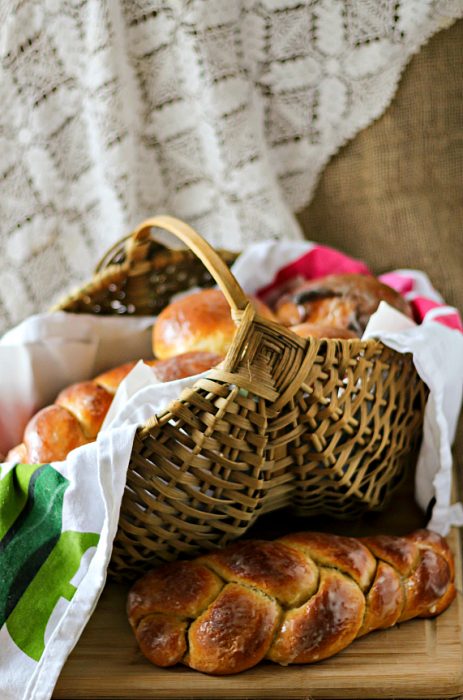
I have made Cornish Saffron Bread before. Last year, I made it in three different shapes and used eggs from our girls to decorate it.
(I also have you covered with other Easter bread recipes from around the world.)
So Why did I make a repeat version of this Cornish Easter bread again?
Pastry Chef Online Participates in Affiliate Programs. If you make a purchase through one of my links, I may earn a small commission. For more information click to read my disclosure policy
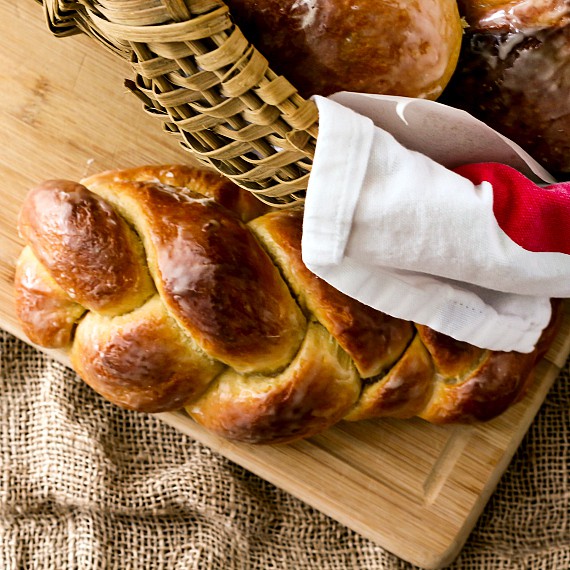
You guys know I make the Communion bread for Nadine’s church, right? Well, they only have Communion four times a year: the first Sunday in January, April, July and October. This year, Easter coincided with their Communion, so I wanted the bread to be extra special. Rich and sweet, bright and warm with the promise of both Easter and springtime. I proposed this bread to Nadine, and she was All In. We decided that a very thin glaze would be a nice addition, but I warned her to have some handiwipes available since her hands would get sticky during the ceremonial Breaking of the Bread. She said she keeps some stashed behind the pulpit! She is always prepared.
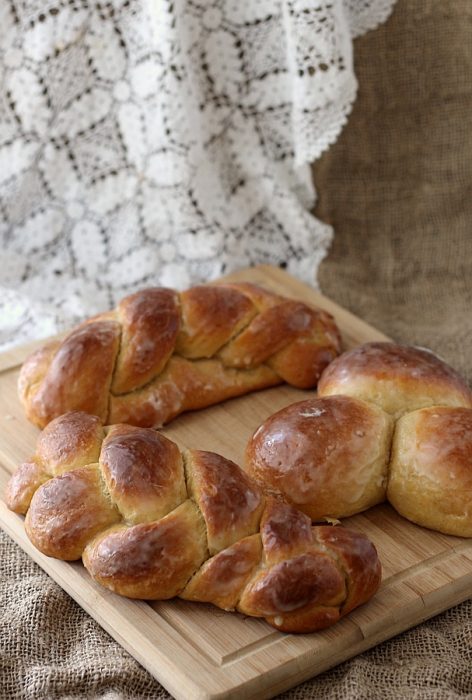
Not only did I get to make this wonderful bread for my friend, I also get to share it for #BreadBakers. This month’s theme is Easter and Passover breads from around the world, and the Cornish Saffron Bread fits in perfectly. I chose to use the Tangzhong method to make this bread, just as I did last year. I find that very rich breads (this dough contains 8 oz butter, a cup of sugar and 2 eggs) tends to get dry rather quickly. Tangzhong helps to fight quick staling by binding up a good portion of the liquid in starch so it can’t get out. Tangzhong method dough is like Hotel California for water. It can check out any time it wants, but it can never leave. That’s perhaps not the most Easter-centric metaphor, but I’m sticking with it.
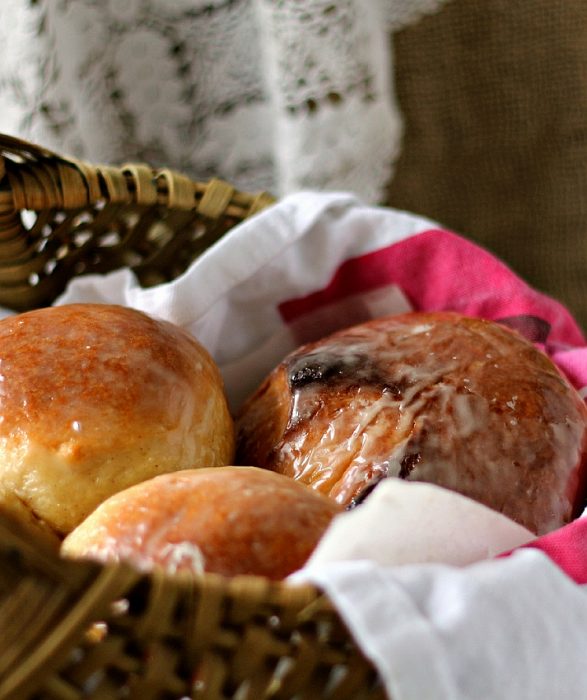
Tangzhong dough is not hard to make, but it is stickier than “regular” bread dough and requires a longer kneading time since some of the gluten isn’t going to form because it’s bound up in the Tangzhong starch matrix. Because this dough is so rich, it also takes a very long time to rise. I used 2 teaspoons of yeast and let it rise in the microwave along with a mug of steaming hot water, and it still took almost 5 hours to double in size. Needless to say, do not make this bread if you are an impatient person! After the rise, I pressed out the gases, stuck the dough in an oiled zip top bag and let it rest in the fridge overnight. I shaped the dough straight from the fridge and then let it rise again until nice and puffy. Even the second rise took a good couple of hours. What you lose in patience, you more than make up for in flavor. I promise.
After baking, I brushed on a thin glaze consisting of powdered sugar, some bottled key lime juice, strained orange juice, a pinch of salt and a few dashes of orange & fig bitters made my local bitters maker, Crude Bitters. I have just begun to incorporate bitters into my baked goods, and I highly recommend this course of action. The bitters brings subtle but very complex flavor and aroma to the proceedings, and the idea is definitely worth playing with.
Enjoy this rich and delicious sweet bread as is, and also know that you can use it as the base for cinnamon rolls or other filled sweet rolls, although you may want to reduce the butter by up to half so the dough is easier to work with. Feel free to add in some toasted nuts either in the dough or as garnish, and some dried fruits would be a fantastic addition as well.
That’s enough going on about the bread. Let me show you how to make this Cornish saffron Easter Bread, and then get ready to enjoy everyone’s offerings this month.
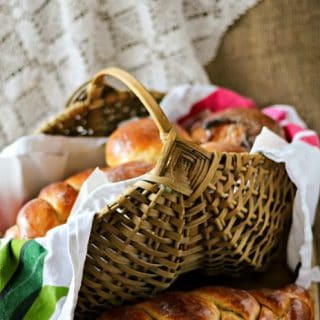
Cornish Saffron Easter Bread
Ingredients
For the Tangzhong
- 2.7 oz bread flour (I use King Arthur)
- 12 oz whole milk
- 1.5 oz water
For the Dough
- All the Tangzhong , cooled to lukewarm
- 24.3 oz bread flour (I use King Arthur)
- 2 large eggs
- 1 Tablespoon kosher salt (don’t worry–the bread doesn’t taste salty)
- 7 oz 1 cup granulated sugar
- 2 teaspoons active dry yeast
- zest of one lime
- zest of one orange
- 1 teaspoon cinnamon
- ½ teaspoon freshly grated nutmeg
- 1 teaspoon saffron threads ground to powder (or 1/2 teaspoon powdered saffron) steeped in 2.5 oz boiling water, cooled to lukewarm
- 8 oz 2 sticks unsalted butter, very soft
For the Glaze
- ¾ cup sifted powdered sugar
- 2 teaspoons key lime juice (I use Nelly & Joe’s)
- tiny pinch of salt
- a few drops Crude Bitters “Sycophant” Orange & Fig Bitters (optional) or use another orange bitters
- enough strained orange juice to give your glaze about the consistency of Elmer’s Glue. Add a teaspoon at a time until you get there.
Instructions
For the Tangzhong
- Cook the flour, milk and water together until thickened, whisking constantly over medium heat.
- Let cool.
For the Dough
- Put all the rest of the dough ingredients in the bowl of your heavy duty stand mixer fitted with the dough hook.
- Mix on low speed until all the ingredients are combined.
- Cover the bowl (still on the mixer) and let the dough rest for about 30 minutes.
- Knead on medium low speed for ten minutes. Cover the mixer and let the dough rest again for another 20-30 minutes.
- Knead another 10 minutes on medium-low speed. Check the dough to see if it will pass the windowpane test. If not, let it rest for another 20 minutes or so and knead again for 5 minutes. You can also finish by vigorously kneading by hand if you want.
- Once the dough is smooth and supple and passes the windowpane test, shape it into a smooth ball and place it back in the mixing bowl. smooth side up. Spray the dough with a bit of oil or pan spray and then cover with plastic wrap or a lint-free towel.
- Let rise in a warm place until doubled in bulk, about 4-5 hours, depending on the temperature of the dough and the temperature of the warm place you let it rise.
- When the dough has doubled, gently press out the gases.
- Put the dough in a gallon-sized zip top bag and let rest in the fridge overnight (at least 8 hours).
- When ready to shape your dough, remove the dough from the fridge and weigh it. You should have right around 60 oz of dough. I scaled my dough into 5 12 oz pieces and shaped each one a bit differently. You can also make larger loaves by scaling into 3 20 oz pieces or 4 15 oz pieces. This part is completely up to you.
- Shape each piece however you would like, including baking as loaves if you’d like. Place each finished dough on parchment-lined sheet trays, spray with pan spray, cover and let rise in a warm place until puffy and not quite doubled in size, about 2 hours.
- Bake at 425F for the first 10 minutes, then reduce the heat to 350F and bake until the internal temperature of the bread reaches 195-200F, about 25 minutes total. If baking on two racks (I had to), swap trays top to bottom and rotate each tray 180F to ensure even baking. If any of the loaves start to get overly browned before they are done, cover them loosely with foil.
- When done, remove the loaves to racks to cool. Brush a thin layer of the glaze evenly on each loaf. It should be almost transparent. Of course, if you like a lot of glaze, add more after the first layer sets up.
- Serve at room temperature. This bread is also delicious toasted. You don’t need to slather any butter on it since it is already so rich, but jam wouldn’t hurt.
- Enjoy!
Did You Make Any Changes?
Nutrition
And there you have it. It looks like a lot, but really it’s mostly waiting around for the dough to rise. Remember to work your dough while it’s still cold and use pan spray/oil as needed (along with your bench knife) to keep sticking to a minimum. This bread is so rich that the texture is almost cake-like. Think brioche. I think you will be a fan. I know I am, and I know that Nadine’s congregation all were thrilled to have such a special bread as a part of their Easter Communion service.
I cannot tell you enough how much I love making the bread for my friend’s services.
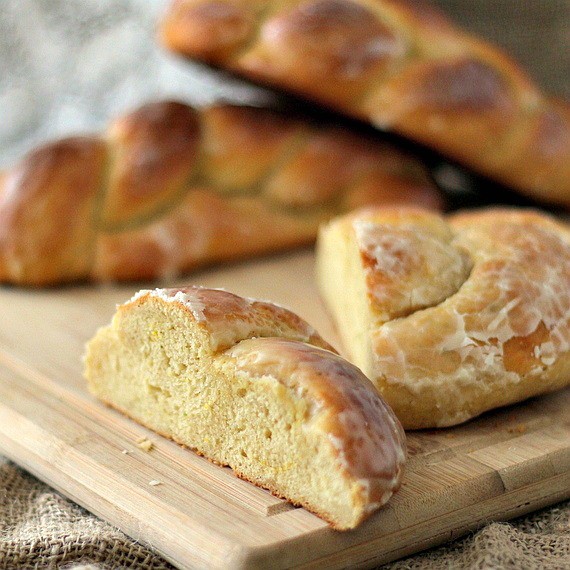
Who Are the #BreadBakers?
#BreadBakers is a group of bread loving bakers who get together once a month to bake bread with a common ingredient or theme. You can see all our of lovely bread by following our Pinterest board right here. Links are also updated after each event on the BreadBakers home page.
We take turns hosting each month and choosing the theme/ingredient. This month Camilla at Culinary Adventures with Camilla has chosen breads from around the world that are traditional for Easter, Passover or Springtime. (And a huge thank you from me to Camilla for choosing this theme–as always, the diversity of offerings is just amazing!)
If you are a food blogger and would like to join us, just send an email with your blog URL to Stacy at [email protected].
And now, for the amazing round up of Easter/Passover/Spring Breads from our very talented group of #BreadBakers

- Bacci Bread by A Day in the Life on the Farm
- Casatiello by Culinary Adventures with Camilla
- Choereg – Armenian Easter Bread by Chef Mireille’s East West Realm
- Colomba Pasquale (Easter Dove Bread) by Cook’s Hideout
- Cornish Saffron Easter Bread by Pastry Chef Online
- Folar (Portuguese Easter Bread) by Passion Kneaded
- Hot Cross Buns by En la Cocina de Caro
- Hornazo De Salamanca – Spanish Easter Bread by Ruchik Randhap
- Hungarian Egg Twist by Hostess at Heart
- Hungarian White Bread by Magnolia Days
- Individual Braided Easter Bread by Hezzi-D’s Books and Cooks
- Italian Easter Bread by La Cocina de Aisha
- Lambropsomo – Greek Easter Bread by Spice Roots
- Lithuanian Easter Raisin Bread by My Catholic Kitchen
- Matzo by A Shaggy Dough Story
- Mennonite Paska by Food Lust People Love
- Pääsiäisleipä – Finnish Easter Bread by Bakers and Best
- Pane di Pasqua – Italian Easter Bread Wreath by Karen’s Kitchen Stories
- Polish Bobka Easter Bread by Seduction in the Kitchen
- Russian Kulich by That’s My Home
- Springtime Sweet Bread by Cooking club
- Strawberry Fritters by Cindy’s Recipes and Writings
- Tsoureki (Greek Easter Bread) by Simply Veggies
Pretty great round up, wouldn’t you say? Enjoy all of these breads. I hope you are inspired to make some of your own.
Thank you for spending some time here today. Take care, and have a lovely day.
PS One braided loaf and one round loaf went to Nadine. (The braid was for breaking and the round loaf was for cutting into tiny portions for the service.) I gave a 3-lobed “Trinity Bread” to my parents (three rounds of dough that bake together. You slice one thin piece from each round to signify “Father, Son and Holy Spirit” at Easter). We kept the uglier of the two braids and a sort of spiral twist. If you don’t want to commit to 60 oz of bread, you could half the recipe, but it’s really delicious and it freezes well, so you may as well just go for it.



Join in Today!
I hope that your readers will definitely try making this bread. I can attest that is, indeed, delicious and my congregation devoured the leftovers immediately after worship. It’s a lovely gift that you share with my church and I’m glad you are sharing it with others as well. Thanks Jenni!
You know it’s one of my favorite things to do, Nadine! I’m so glad you stopped in to say howdy! xo
Wow, that is such a rich and beautiful braided bread. I love Tangzhong starter — it gives the bread a very nice crumb. Love that handmade braided basket 🙂
Thanks, Pavani! I just learned about the method early last year, and now I adapt most of my rich breads to the method. It does wonders for texture and keeping properties. Glad you like the basket too; it’s a treasure. <3